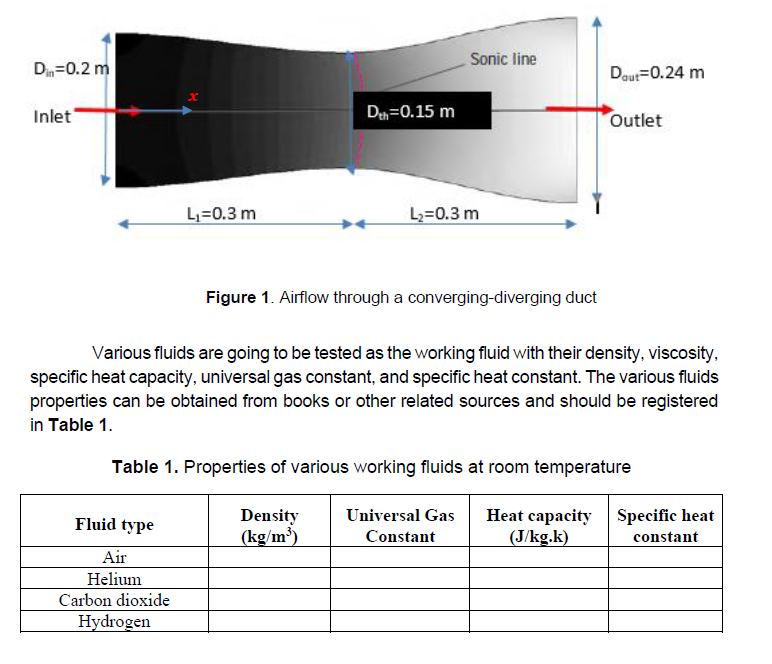The converging-diverging flow domain is shown in Figure 1. The inlet diameter is 0.2 m, the throat diameter is 0.15 m, and the outlet diameter is 0.24 m
The converging-diverging flow domain is shown in Figure 1. The inlet diameter is 0.2 m, the throat diameter is 0.15 m, and the outlet diameter is 0.24 m
Elements Of Electromagnetics
7th Edition
ISBN:9780190698614
Author:Sadiku, Matthew N. O.
Publisher:Sadiku, Matthew N. O.
ChapterMA: Math Assessment
Section: Chapter Questions
Problem 1.1MA
Related questions
Question
The converging-diverging flow domain is shown in Figure 1. The inlet diameter is 0.2 m, the throat diameter is 0.15 m, and the outlet diameter is 0.24 m. The axial distance from the inlet to the throat is 0.30 m—the same as the axial distance from the throat to the outlet. At the inlet section, the stagnation pressure P0 is set to 220 kPa (absolute), while the stagnation temperature T0, at the inlet is set to 300 K.

Transcribed Image Text:Sonic line
D=0.2 m
Daut=0.24 m
Inlet
Dn=0.15 m
Outlet
L=0.3 m
L2=0.3 m
Figure 1. Airflow through a converging-diverging duct
Various fluids are going to be tested as the working fluid with their density, viscosity,
specific heat capacity, universal gas constant, and specific heat constant. The various fluids
properties can be obtained from books or other related sources and should be registered
in Table 1.
Table 1. Properties of various working fluids at room temperature
Heat capacity
(J/kg.k)
Specific heat
Density
(kg/m³)
Universal Gas
Fluid type
Constant
constant
Air
Helium
Carbon dioxide
Hydrogen
Expert Solution
This question has been solved!
Explore an expertly crafted, step-by-step solution for a thorough understanding of key concepts.
Step by step
Solved in 3 steps with 3 images

Knowledge Booster
Learn more about
Need a deep-dive on the concept behind this application? Look no further. Learn more about this topic, mechanical-engineering and related others by exploring similar questions and additional content below.Recommended textbooks for you

Elements Of Electromagnetics
Mechanical Engineering
ISBN:
9780190698614
Author:
Sadiku, Matthew N. O.
Publisher:
Oxford University Press

Mechanics of Materials (10th Edition)
Mechanical Engineering
ISBN:
9780134319650
Author:
Russell C. Hibbeler
Publisher:
PEARSON

Thermodynamics: An Engineering Approach
Mechanical Engineering
ISBN:
9781259822674
Author:
Yunus A. Cengel Dr., Michael A. Boles
Publisher:
McGraw-Hill Education

Elements Of Electromagnetics
Mechanical Engineering
ISBN:
9780190698614
Author:
Sadiku, Matthew N. O.
Publisher:
Oxford University Press

Mechanics of Materials (10th Edition)
Mechanical Engineering
ISBN:
9780134319650
Author:
Russell C. Hibbeler
Publisher:
PEARSON

Thermodynamics: An Engineering Approach
Mechanical Engineering
ISBN:
9781259822674
Author:
Yunus A. Cengel Dr., Michael A. Boles
Publisher:
McGraw-Hill Education

Control Systems Engineering
Mechanical Engineering
ISBN:
9781118170519
Author:
Norman S. Nise
Publisher:
WILEY

Mechanics of Materials (MindTap Course List)
Mechanical Engineering
ISBN:
9781337093347
Author:
Barry J. Goodno, James M. Gere
Publisher:
Cengage Learning

Engineering Mechanics: Statics
Mechanical Engineering
ISBN:
9781118807330
Author:
James L. Meriam, L. G. Kraige, J. N. Bolton
Publisher:
WILEY